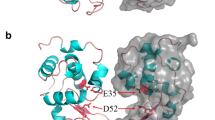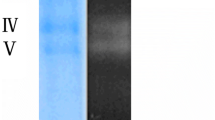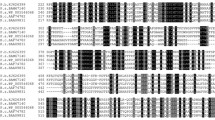Abstract
In the presented research the extracellular chitinase of Stenotrophomonas rhizophila G22 was biochemically and molecularly characterized. The studied enzyme was purified from a 72-h bacterial culture about 14 times, with a recovery of 63%. The molecular weight of the purified protein was estimated at 50 kDa by SDS-PAGE. The enzyme showed high activity against colloidal chitin. Significantly lower activities were observed with native chitin powder and chitosan. Adsorption of the enzyme to colloidal chitin and to powdered chitin at the level of 75% and 37%, respectively, was observed after 30 min of reaction. Optimum temperature and pH were 37 °C and 5.9, respectively. The enzyme demonstrated higher activity against nitrophenyl-β d N, N′, N″-triacetylchitotriose and approx. 5 times lower activity for 4-nitrophenyl-N, N′-diacetyl-β-d-chitobiose. The enzyme is an endochitinase, which is confirmed by the Km and Vmax values determined in the studies. S. rhizophila G22 endochitinase was inhibited in the presence of cysteine-specific inhibitors, which indicates the role of cysteine moieties in the mechanism of catalysis or in stabilisation of the enzyme molecule. Also Ca2+ and Mn2+ ions may stabilise the protein's spatial structure. SDS and ions: Fe2+, Cu2+, Co2+, Zn2+ inhibited the activity of enzyme. A full-length (2109 bp) gene coding chitinase from S. rhizophila G22 was obtained. Four domains typical for glycoside hydrolase family 18 (GH 18) chitinases were identified: catalytic Gly_18, chitin-binding—ChtBD3, type-III fibronectin—FN3 and polycystic kidney disease domain—PKD domain.







Similar content being viewed by others
References
Adrangi S, Faramarzi MA (2013) From bacteria to human: a journey into the world of chitinases. Biotechnol Adv 31(8):1786–1995
Alam MM, Mizutani M, Isono T, Nikaidou N, Watanabe T (1996) Three chitinase genes (chiA, chiC and chiD) comprise the chitinase system of Bacillus circulans WL-12. J Ferment Bioeng 82:28–36
Aliabadi N, Aminzadeh S, Karkhane AA, Haghbeen K (2016) Thermostable chitinase from Cohnella sp. A01: isolation and product optimization. Braz J Microbiol 47(4):931–940
Bhattacharya S, Das A, Samadder S, Rajan SS (2016) Biosynthesis and characterization of a thermostable, alkali-tolerant chitinase from Bacillus pumilus JUBCH08 displaying antagonism against phytopathogenic Fusarium oxysporum. 3 Biotech. https://doi.org/10.1007/s13205-016-0406-x
Bhuvanachandra B, Madhuprakash J, Podile AR (2018) Active-site mutations improved the transglycosylation activity of Stenotrophomonas maltophilia chitinase. A Biochim Biophys Acta Proteins Proteom 1866(3):407–414
Bohr S, Patel SJ, Vasko R, Shen K, Golberg A, Berthiaume F, Yarmush ML (2015) The role of CHI3L1 (Chitinase-3-Like-1) in the pathogenesis of infections in burns in a mouse model. PLoS ONE ONE 10:1–19
Bradford MM (1976) A rapid and sensitive method for the quantitation of microgram quantities of protein utilizing the principle of protein-dye binding. Anal Biochem 72:248–254
Chu F, Wang D, Liu T, Han H, Yu Y, Yang Q (2019) An optimized cocktail of chitinolytic enzymes to produce N, N'-diacetylchitobiose and N-acetyl-d-glucosamine from defatted krill by-products. Int J Biol Macromol 133:1029–1034
Davies G, Henrissat B (1995) Structures and mechanisms of glycosyl hydrolases. Structure 3(9):853–859
Deng JJ, Shi D, Mao HH, Li ZW, Liang S, Ke Y, Luo XC (2019) Heterologous expression and characterization of an antifungal chitinase (Chit46) from Trichoderma harzianum GIM 3.442 and its application in colloidal chitin conversion. Int J Biol Macromol 1(134):113–121
Fu X, Yan Q, Wang J, Yang S, Jiang Z (2016) Purification and biochemical characterization of novel acidic chitinase from Paenicibacillus barengoltzii. Int J Biol Macromol 91:973–979
Hernandez-Montiel LG, Zulueta-Rodriguez R, Angulo C, Rueda-Puente EO, Quiñonez-Aguilar E, Galicia R (2017) Marine yeasts and bacteria as biological control agents against anthracnose on mango. J Phytopathol 165:833–840
Huang QS, Xie XL, Liang G, Gong F, Wang Y, Wei XQ, Wang Q, Ji ZL, Chen QX (2012) The GH18 family of chitinases: their domain architectures, functions and evolutions. Glycobiology 22(1):23–34
Jabeen F, Hussain A, Manzoor M, Younis T, Rasul A, Qazi JI (2018) Potential of bacterial chitinolytic, Stenotrophomonas maltophilia, in biological control of termites. Egypt J Biol Pest Co 28(86):1–10
Jankiewicz U, Swiontek Brzezinska M (2015) Purification, characterization and gene cloning of a chitinase from Stenotrophomonas maltophilia N4. J Basic Microbiol 55(6):709–717
Jankiewicz U, Larkowska E, Swiontek Brzezinska M (2016) Production, characterization, gene cloning and nematocidal activity of the extracellular protease from Stenotrophomonas maltophilia N4. J Biosci Bioeng 121(6):614–618
Kobayashi DY, Reedy RM, Bick J, Oudemans PV (2002) Characterization of a chitinase gene from Stenotrophomonas maltophilia strain 34S1and its involvement in biological control. Appl Environ Microbiol 68(3):1047–1054
Kumirska J, Weinhold MX, Thöming J, Stepnowski P (2011) Biomedical activity of chitin/chitosan based materials—influence of physicochemical properties apart from molecular weight and degree of N-acetylation. Polymers 3:1875–1901
Kuusk S, Kont R, Kuusk P, Heering A, Sørlie M, Bissaro B, Eijsink VGH, Väljamäe P (2019) Kinetic insights into the role of the reductant in H2O2-driven degradation of chitin by a bacterial lytic polysaccharide monooxygenase. J Biol Chem 294(5):1516–1528
Laemmli UK (1970) Cleavage of structural proteins during assembly of head of bacteriophages T4. Nature 227:680–685
Liu CL, Shen CR, Hsu FF, Chen JK, Wu PT, Guo SH, Lee WC, Yu FW, Mackey ZB, Turk J, Gross ML (2009) Isolation and identification of two novel SDS-resistant secreted chitinases from Aeromonas schubertii. Biotechnol Prog 25(1):124–131
Liu T, Duan Y, Yang Q (2018) Revisiting glycoside hydrolase family 20 β-N-acetyl-d-hexosaminidases: crystal structures, physiological substrates and specific inhibitors. Biotechnol Adv 36(4):1127–1138
Majeti NV, Ravi K (2000) A review of chitin and chitosan applications. React Funct Polym 46:1–27
Miller GL (1959) Use of dinitrosalicylic acid reagent for determination of reducing sugar. Anal Chemistry 31:426–429
Rabeeth M, Anitha A, Srikanth G (2011) Purification of an antifungal endochitinase from a potential biocontrol agent Streptomyces griseus. Pak J Biol Sci 14(16):788–797
Ray L, Panda AN, Mishra SR, Pattanaik AK, Adhya TK, Suar M, Raina V (2019) Purification and characterization of an extracellular thermo-alkali stable, metal tolerant chitinase from Streptomyces chilikensis RC1830 isolated from a brackish water lake sediment. Biotechnol. Rep 29(21):e00311
Roberts WK, Selitrennikoff CP (1988) Plant and bacterial chitinases differ in antifungal activity. J Gen Microbiol 134:169–176
Romaguera A, Menge U, Breves R, Diekmann H (1992) Chitinases of Streptomyces olivaceoviridis and significance of processing for multiplicity. J Bacteriol 174(11):3450–3454
Schmidt CS, Alavi M, Cardinale M, Müller H, Berg G (2012) Stenotrophomonas rhizophila DSM14405T promotes plant growth probably by altering fungal communities in the rhizosphere. Biol Fertil Soils 48(8):947–960
Senol M, Nadaroglu H, Dikbas N, Kotan R (2014) Purification of Chitinase enzymes from Bacillus subtilis bacteria TV-125, investigation of kinetic properties and antifungal activity against Fusarium culmorum. Ann Clin Microbiol Antimicrob 13:35
Shaikh SS, Wani SJ, Sayyed RZ, Thakur R, Gulati A (2018) Production, purification and kinetics of chitinase of Stenotrophomonas maltophilia isolated from rhizospheric soil. Indian J Exp Biol 56(4):274–278
Sosnowska ME, Jankiewicz U, Kutwin M, Chwalibog A, Gałązka A (2018) Influence of salts and metal nanoparticles on the activity and thermal stability of a recombinant chitinase from Stenotrophomonas maltophilia N4. Enzyme Microb Technol 116:6–15
Suma K, Podile AR (2013) Chitinase A from Stenotrophomonas maltophilia shows transglycosylation and antifungal activities. Bioresour Technol 133:213–220
Swiontek Brzezinska M, Jankiewicz U, Burkowska A, Walczak M (2014) Chitinolytic microorganisms and their possible application in environmental protection. Curr Microbiol 68(1):71–81
Swiontek Brzezinska M, Jankiewicz U, Kalwasinska A, Swiatczak J, Zero K (2019) Characterization of chitinase from Streptomyces luridiscabiei U05 and its antagonist potential against fungal plant pathogens. J Phytopathol 167(7–8):404–412
Vaaje-Kolstad G, Horn SJ, van Aalten DM, Synstad B, Eijsink VG (2005) The non-catalytic chitin-binding protein CBP21 from Serratia marcescens is essential for chitin degradation. J Biol Chem 280(31):28492–28497
Vaaje-Kolstad G, Horn SJ, Sørlie M, Eijsink VG (2013) The chitinolytic machinery of Serratia marcescens—a model system for enzymatic degradation of recalcitrant polysaccharides. FEBS J 280(13):3028–3049
Vogan CL, Powell A, Rowley AF (2008) Shell disease in crustaceans—just chitin recycling gone wrong? Environ Microbiol 10(4):826–835
Wang X, Chi N, Bai F, Du Y, Zhao Y, Yin H (2016) Characterization of a cold-adapted and salt-tolerant exo-chitinase (ChiC) from Pseudoalteromonas sp. DL-6. Extremophiles 20(2):67–76
Wang D, Li A, Han H, Liu T, Yang Q (2018) A potent chitinase from Bacillus subtilis for the efficient bioconversion of chitin-containing wastes. Int J Biol Macromol 116:863–868
Yahiaoui M, Laribi-Habchi H, Bouacem K, Asmani KL, Mechri S, Harir M, Bendif H, Aïssani-El Fertas R, Jaouadi B (2019) Purification and biochemical characterization of a new organic solvent-tolerant chitinase from Paenibacillus timonensis strain LK-DZ15 isolated from the Djurdjura Mountains in Kabylia, Algeria. Carbohydr Res 15:8. https://doi.org/10.1016/j.carres.2019.107747
Zarei M, Aminzadeh S, Zolgharnein H, Safahieh A, Daliri M, Noghabi KA, Ghoroghi A, Motallebi A (2011) Characterization of a chitinase with antifungal activity from a native Serratia marcescens B4A. Braz J Microbiol 42(3):1017–1029
Zhu W, Wang D, Liu T, Yang Q (2016) Production of N-acetyl-d-glucosamine from mycelial waste by a combination of bacterial chitinases and an insect N-acetyl-d-glucosaminidase. J Agric Food Chem 64(35):6738–6744
Acknowledgments
This research was financed by the statutory activity of the Department Biochemistry, Warsaw University of Life Sciences—SGGW
Author information
Authors and Affiliations
Contributions
UJ, BB and MSB and MF designed the study. UJ, BB and MSB performed the research. UJ analysed the data and wrote the paper. All authors read and approved the final manuscript.
Corresponding author
Ethics declarations
Conflict of interest
All authors declare that they have no conflict of interest. No grants were received.
Ethical approval
This article does not contain any studies with human participants or animals performed by any of the authors.
Accession numbers
16S rRNA gene sequence for G22 bacteria was deposited in the DDBJ/EMBL/GenBank with the number: LC494522. The gene sequence of chitinase was deposited in the DDBJ/EMBL/GenBank with the number: LC497040.
Rights and permissions
About this article
Cite this article
Jankiewicz, U., Baranowski, B., Swiontek Brzezinska, M. et al. Purification, characterization and cloning of a chitinase from Stenotrophomonas rhizophila G22. 3 Biotech 10, 16 (2020). https://doi.org/10.1007/s13205-019-2007-y
Received:
Accepted:
Published:
DOI: https://doi.org/10.1007/s13205-019-2007-y




